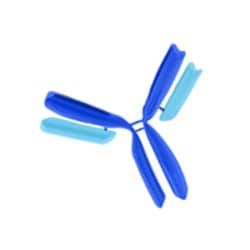MAB1976Z
Anti-Integrin αVβ3 Antibody, clone LM609, Azide Free
clone LM609, Chemicon®, from mouse
Manufacturer: Sigma Aldrich
Synonym(S): VitronectinReceptor, CD51/CD61, MAB1976
Select a Size
| Pack Size | SKU | Availability | Price |
|---|---|---|---|
| 100 μG | MAB1976Z-100-μG | In Stock | ₹ 58,900.00 |
MAB1976Z - 100 μG
In Stock
Quantity
1
Base Price: ₹ 58,900.00
GST (18%): ₹ 10,602.00
Total Price: ₹ 69,502.00
biological source
mouse
Quality Level
100
antibody form
purified immunoglobulin
antibody product type
primary antibodies
clone
LM609, monoclonal
species reactivity
human, canine, pig, rabbit, bovine, chicken, monkey, avian
should not react with
mouse, rat
manufacturer/tradename
Chemicon®
technique(s)
flow cytometry: suitableimmunohistochemistry: suitableimmunoprecipitation (IP): suitable
isotype
IgG1
Description
- General description: The integrin family of cell adhesion receptors consists of at least 16 membrane-associated heterodimers, composed of an alpha and beta subunit that associate in a non-covalent manner. The structure and functional diversity of the integrin family are based upon the pairing abilities of the individual alpha and beta subunits. Key to these molecular interactions between the integrin receptors and their respective ligands is the recognition of the Arg-Gly-Asp (RGD) sequence, known to be present in the extracellular matrix components fibronectin, vitronectin, collagen, fibrinogen, and von Willebrand factor (Cheresh, 1991). The involvement of integrins in vascular proliferation, adhesion, and wound repair has been well documented. The adhesion receptor, integrin alphaVbeta3, appears to be selectively expressed on growing blood vessels and has been identified as a marker of angiogenic vascular tissue (Brooks, 1994). Due to its involvement in angiogenesis, integrin alphaVbeta3 is one of the most intensely studied of the integrin receptors.
- Specificity: Reacts with the vitronectin receptor alphaVbeta3 complex, an RGD-directed adhesion receptor. LM609 has been demonstrated to block adhesion of a human melanoma cell line (M21) to vitronectin, fibrinogen and von Willebrand factor, as well as to a synthetic RGD containing peptide (Cheresh, 1987). In chick chorioallentoic membranes, LM609 was shown to block angiogenesis induced by bFGF and TNFalpha but had no effect on pre-existing vessels (Brooks, 1994). While LM609 does block cell attachment to RGD containing ligands, it does not interact directly with the RGD binding site. Instead, LM609 appears to be an allosteric inhibitor of integrin alphaVbeta3, which binds to a conformational epitope resulting from the post-translational association of the alphaV and beta3 subunits.
- Immunogen: Purified adhesion receptor from the human melanoma cell line M21 (Cheresh, 1987).
- Application: Flow Cytometry: 1-3 μg LM609 per 0.5 x 10e6 cells in 100μL (Smith, 1996). Immunoprecipitation: specifically immunoprecipitates the integrin alphaVbeta3 complex which, when resolved by SDS-PAGE under reducing conditions, results in an approximately 130 kDa band corresponding to the alphaV subunit and a 105 kDa band corresponding to the beta3 subunit (Cheresh, 1987). Immunofluorescence: 5-10 μg/mL for staining of bFGF-treated 6 mm cryosections of chick chorioallantoic membrane fixed with acetone (Brooks, 1994). LM609 is also effective on 4% paraformaldehyde fixed, frozen tissues and cells. However it is not effective for immunohistochemical staining of paraffin-embedded tissue sections. Inhibits adhesion of cells to vitronectin coated surfaces at 10-25 μg/mL. Optimal working dilutions and protocols must be determined by end user.
- Target description: Molecular Weight of Integrin αV: 125-135 kDa
- Physical form: Format: Purified
- Storage and Stability: Maintain at 2–8°C in undiluted aliquots for up to 6 months.
- Analysis Note: ControlPositive Control: Human myeloma cell lines M21 and MoαV (Chen, 1995).Negative Control: Mo cells (this cell line was derived from M21 but does not express integrin αVChen, 1995)
- Other Notes: Concentration: Please refer to the Certificate of Analysis for the lot-specific concentration.
- Legal Information: CHEMICON is a registered trademark of Merck KGaA, Darmstadt, Germany
- Disclaimer: Unless otherwise stated in our catalog or other company documentation accompanying the product(s), our products are intended for research use only and are not to be used for any other purpose, which includes but is not limited to, unauthorized commercial uses, in vitro diagnostic uses, ex vivo or in vivo therapeutic uses or any type of consumption or application to humans or animals.
SAFETY INFORMATION
WGK
WGK 2
Flash Point(F)
Not applicable
Flash Point(C)
Not applicable
Compare Similar Items
Show Difference
biological source: mouse
Quality Level: 100
antibody form: purified immunoglobulin
antibody product type: primary antibodies
clone: LM609, monoclonal
species reactivity: human, canine, pig, rabbit, bovine, chicken, monkey, avian
should not react with: mouse, rat
manufacturer/tradename: Chemicon®
technique(s): flow cytometry: suitableimmunohistochemistry: suitableimmunoprecipitation (IP): suitable
isotype: IgG1
biological source:
mouse
Quality Level:
100
antibody form:
purified immunoglobulin
antibody product type:
primary antibodies
clone:
LM609, monoclonal
species reactivity:
human, canine, pig, rabbit, bovine, chicken, monkey, avian
should not react with:
mouse, rat
manufacturer/tradename:
Chemicon®
technique(s):
flow cytometry: suitableimmunohistochemistry: suitableimmunoprecipitation (IP): suitable
isotype:
IgG1



